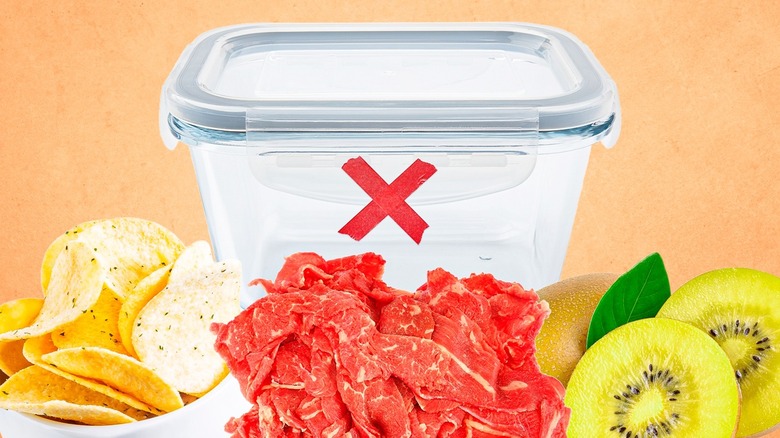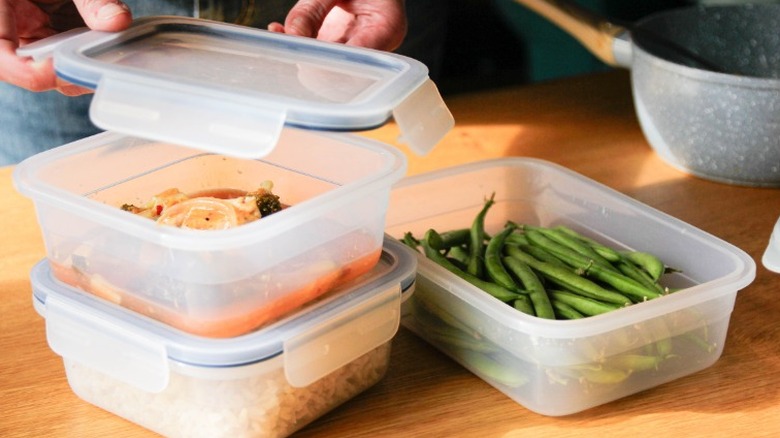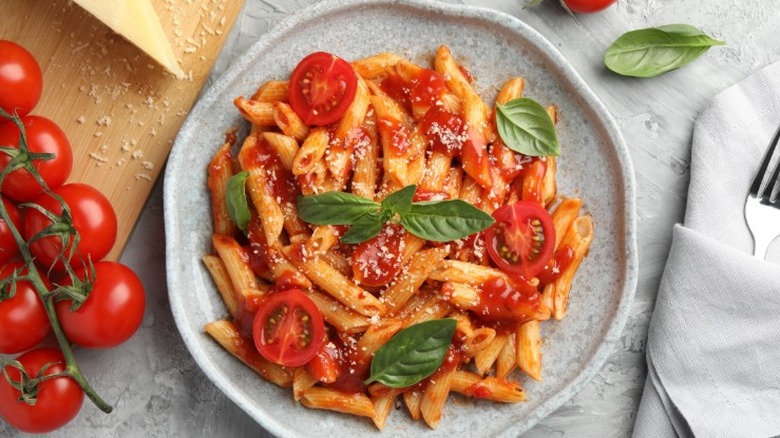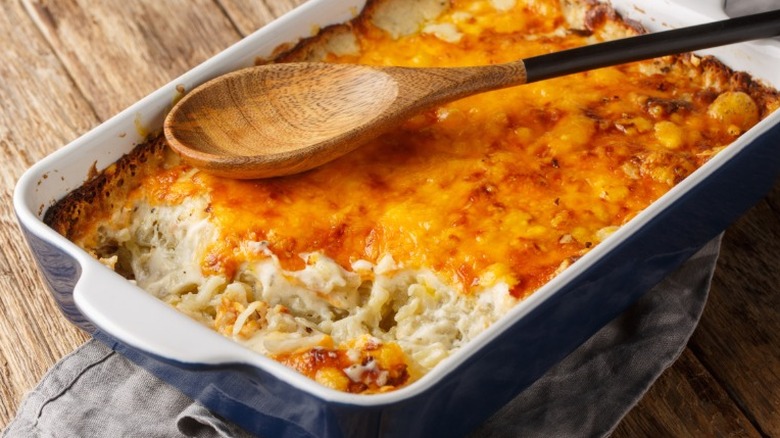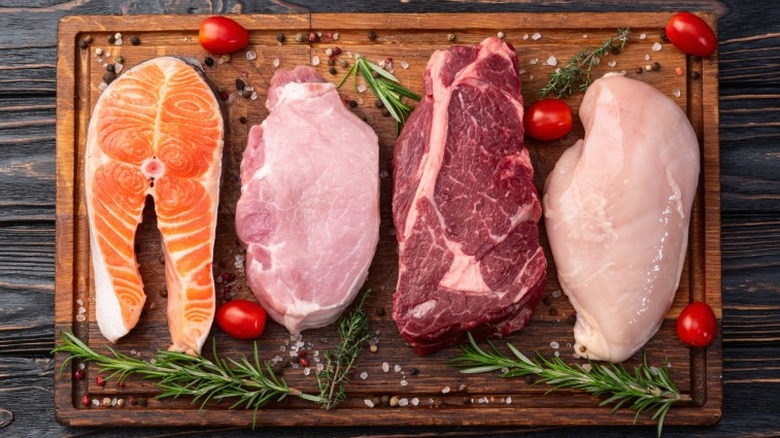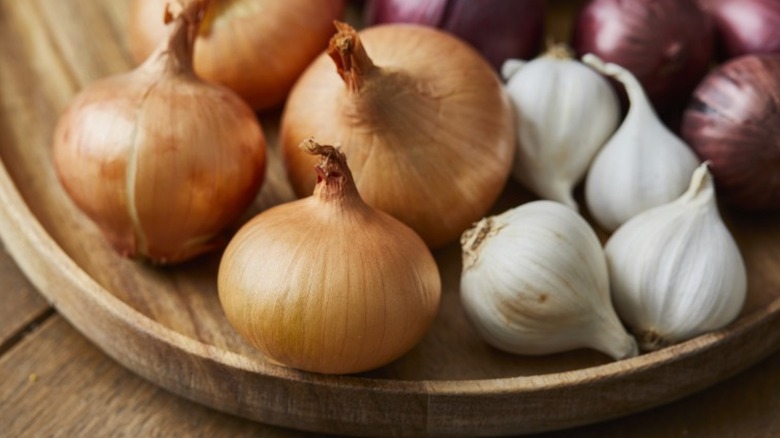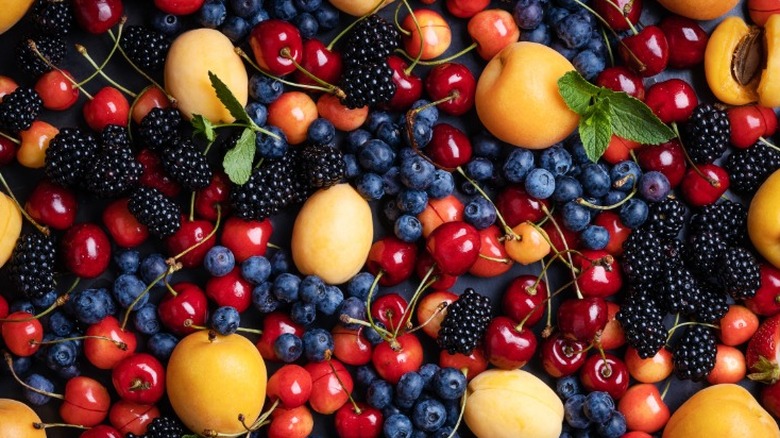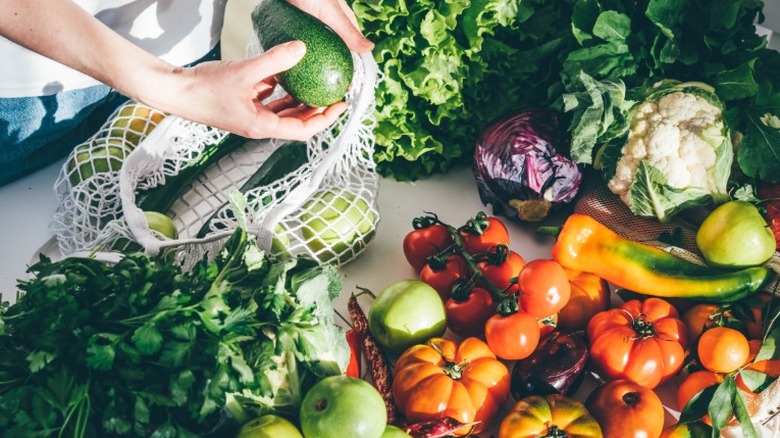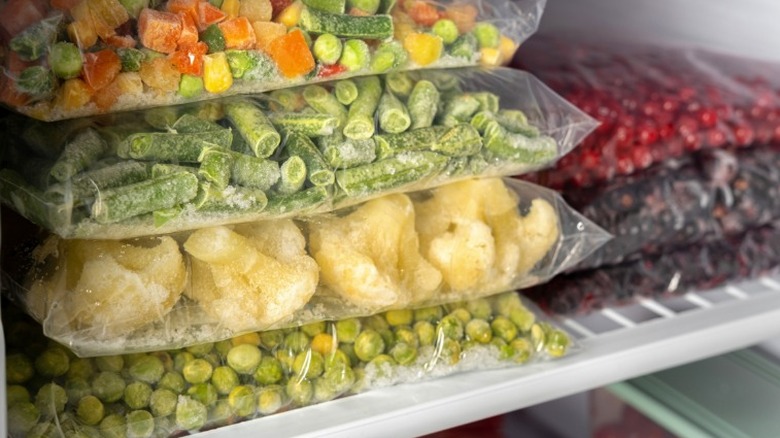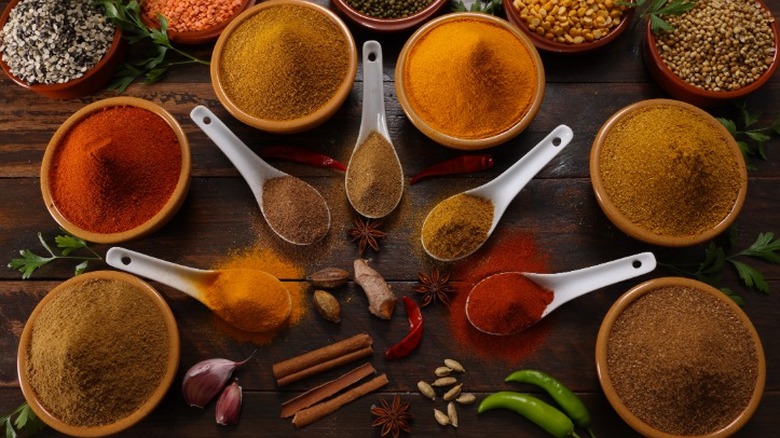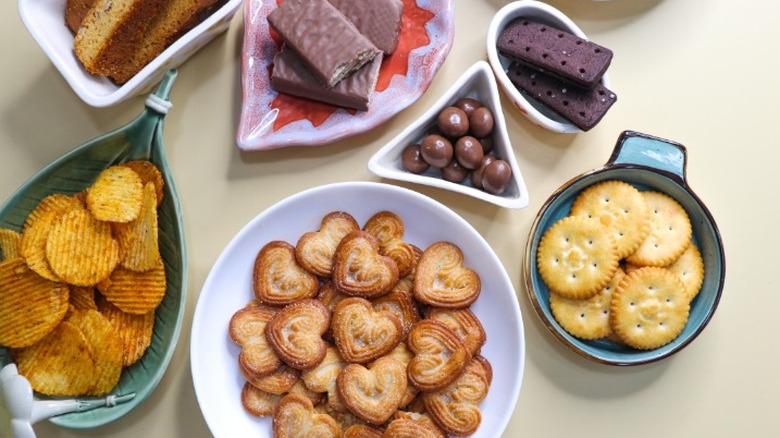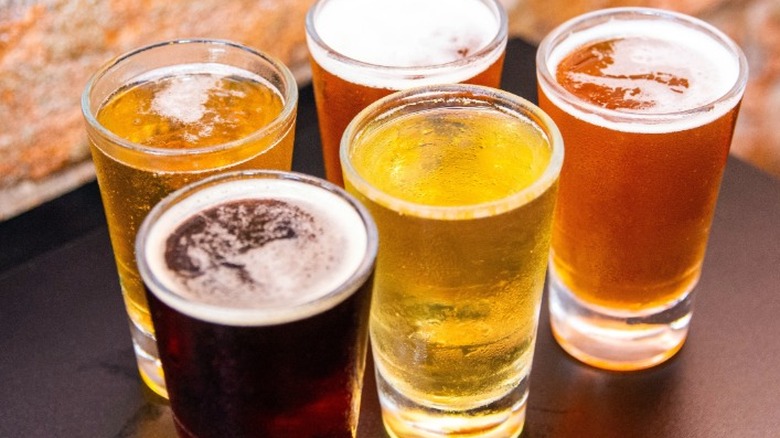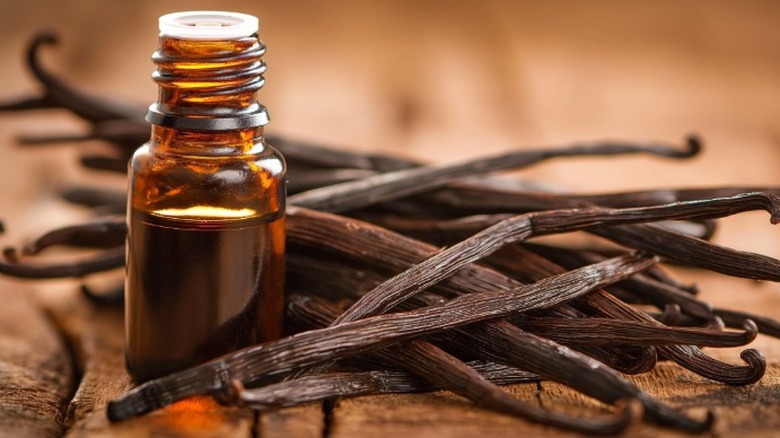12 Types Of Food You Should Avoid Storing In Plastic Containers
If you take a look around your kitchen, you're likely to find at least a few plastic containers, storing anything from dried goods to last night's leftovers. After all, there's a reason so many people turn to these for their storage needs. They're affordable and convenient, especially if you do a lot of cooking at home. But it might be worth double-checking the contents of your plastic containers. Some foods and plastic just don't mix.
Most people know to avoid heating food in plastic and that even "microwave safe" plastic might be a lie. But fewer people think twice about throwing fruit in a plastic tub or storing away their leftover spaghetti from dinner. Even these seemingly benign foods can interact negatively with your storage containers. It could be something as simple as making your food taste off or something more serious, like leaking dangerous chemicals into the contents. Knowing what to avoid can help you prevent both the subtle and more harmful impacts of plastic from costing you perfectly good food. These are 12 types of food that you should keep far away from plastic containers.
Hot foods
While cooking large dinners might be a chore, there's nothing better than knowing you'll have extra to enjoy in the coming days. The week ahead seems much more manageable when you can save time and money on food. In your excitement, you might be tempted to package the excess and throw the containers in the fridge for easy access. But before you act too quickly, know that storing hot food in plastic containers is one big mistake you're making with leftover food.
Most people know you should try to avoid microwaving food in plastic containers, but the heat from uncooled dishes can also cause accelerated chemical leaching. As the plastic reacts to the heat, chemicals like BPA and phthalates present in the plastic can get into your food. Not only that, but plastic containers, especially older ones, tend to lock in moisture. Combine that with the steam rolling off your dinner, and you get the perfect recipe for mold and bacterial growth. Opt for glass containers instead if you want to keep your dinners fresh and flavorful throughout the week.
Acidic foods
Salt, fat, acid, and heat are the four essential elements of cooking, according to award-winning author and chef, Samin Nosrat. But when you're working with plastic containers, you'll need to watch out for a few of those, including acid. Acidic foods like tomato sauces and citruses react with plastic in similar ways to heat. Chemicals leach into food quicker when exposed to acid. Have you ever noticed your plastic containers tinted red after a few too many leftover spaghetti dinners? Well, plastic containers are prone to absorbing the pigments in your food, leading to stubborn stains that even a dishwasher struggles to remove.
The visible stains on the containers give you a clue as to what's happening inside your food. Just like the plastic absorbs color from your food, the food also absorbs unwanted chemicals from the plastic it comes into contact with. So next time you're looking to store tomato sauces, pickles, or citrus fruits, look for non reactive materials. Containers made of glass, stainless steel, or ceramic can all be good options. Not only that, they're also more eco-friendly than containers made with plastics. They keep food fresh for longer, reducing food waste, and last longer than plastic containers usually do.
Fatty and greasy foods
Think of your favorite comfort foods. Some that come to mind might be mac and cheese, lasagna, or your grandma's secret recipe casserole. What do all these have in common? They're fatty and greasy, making them taste extra delicious. But it's those very fats in our favorite dishes that make them a no-go for plastic storage vessels. Fatty foods tend to absorb chemicals more easily from plastics, and can even wear down the plastic in turn.
As plastic becomes worn down over time, it can harbor more bacteria in the scratches and grooves on its surface. It also becomes more likely to release microplastics. Studies in the 1990s and 2000s found that DEHA, a plasticizer used to make some plastic containers softer and more flexible, transferred from plastic into certain types of foods. Most of these foods were fatty like cheeses. When you sit down after a long day to enjoy a rich, cheesy bite of home, you shouldn't have to worry about what might have contaminated that perfect bite. So if you ever wanted to know how to make mac and cheese — the most comforting of comfort foods — even better, the first step is to skip the plastic.
Raw meats
Raw meat is one of those foods that every good cook, and even layperson, knows to handle carefully. Before becoming a juicy burger or a crisp piece of fried chicken, these meats can be a breeding ground for harmful bacteria. E. coli cases are often associated with raw and undercooked ground beef, while other raw meats can cause foodborne illnesses like salmonella. You definitely don't want raw meat juices anywhere near other foods in your kitchen. This is why it's a good rule of thumb to use separate cutting boards and packaging from the ones you use for other ingredients.
However, no matter how many other precautions you take, storing raw meat in plastic containers is a serious risk to your food safety. Raw meat has a lot of juice in it and this juice can seep into your containers. Since plastic containers tend to be porous, making them prone to staining, these juices can linger in the pores, increasing the risk of cross contamination if you choose to reuse the containers for other foods. To store raw meats more safely, use tightly sealed glass containers or bags to trap in those pesky juices.
Pungent foods
Some of the best foods in the world can be smelled from a mile away. Stinky cheese, stinky tofu, and even the ever-controversial durian fruit are all well-loved by many in spite of their strong odors. That said, even if you love these foods, you probably don't want everything to smell like them. If you're finding that strong odors linger in your kitchen, your choice of storage container may be the culprit.
Those stain-trapping pores in plastic containers are also odor-trapping. If you store particularly pungent foods like garlic or onions in these containers, food residue can remain even after washing, leaving behind noticeable smells. Any residues or moisture from the food can also cause bacteria to grow, which can increase the potency of odors. Sometimes even washing can't get smells out and you're stuck with containers that hold onto the memories of lunches past. Avoid plastic and you can avoid the confusion of opening up a container of brownies and being greeted with a whiff of garlic instead.
Fruits
Fruits, at their best, are some of nature's greatest creations. Nothing beats the fresh crunch of an apple or the sweetness of a ripe strawberry. And the best part is, they're actually good for you. But if you don't store them correctly, you could risk losing the fresh flavor and texture that makes up a good piece of fruit. Some fruits, in particular, contain a gas called ethylene. When this gas is released, the fruits ripen more quickly.
If you place fruits that produce ethylene in a plastic container with little ventilation, the gas will be trapped and your fruit will ripen too quickly. For these fruits, breathable storage options like mesh bags and towels can be a better alternative. You should also attempt to separate fruits that produce more ethylene from ones that don't produce as much. Definitely don't cram all types of fruit into one Tupperware container if you want everything to keep well. Juicier fruits like berries can be stored in mason jars. This will help them retain some moisture without trapping so much that they start to spoil the next day. Just make sure to dry them well or, better yet, wait until you're ready to eat to wash them.
Vegetables
Much like fruits, vegetables rely heavily on their freshness to make them shine. And just like their sweeter counterparts, moisture is a common enemy. Airtight plastic containers can turn even newly bought produce into a rotting mess in no time with all the moisture they lock in. This is especially true for leafy vegetables which are fragile and prone to wilting. If you're looking to avoid plastic, there are plenty of alternatives, depending on what kind of vegetable you're storing.
Some vegetables can be left in their original packaging until ready to use. These include leafy greens and broccoli, which sometimes come in perforated containers perfect for keeping them fresh. Things like potatoes do well in dry environments where they have lots of room to breathe. Try out mesh or paper bags with holes for easy ventilation. If you're worried about your vegetables drying out, try this tip you need to store root vegetables correctly. The hack strikes the perfect balance of moisture and air flow that will keep your veggies looking and tasting like they came straight from the farm.
Frozen foods
Sometimes life feels too busy to worry about what's for breakfast, lunch, and dinner. That's why meal prepping has become all the rage and is one of several ways to make a better work lunch that'll last you the whole week. Lots of meal prepping plans involve making large batches of food and freezing portions to be reheated throughout the week. While this is a great time-saving hack, you should try to avoid freezing your concoctions in plastic containers.
Many plastic containers are susceptible to extreme temperatures and the cold of the freezer can cause them to break down. As the plastic breaks down it can leach more chemicals into the contents of the container. Damage to the containers themselves is even a concern. Freezer conditions can cause certain plastic containers to warp and crack. As much as you try to avoid using plastic containers, no one wants to have to throw out something they spent good money on. Instead of wasting money on containers that don't hold up, use freezer bags or glass containers that won't bend under pressure. Silicone freezer bags, in particular, are an easy, environmentally conscious substitute for plastic.
Spices
If there's any messy spot in a kitchen, it's very likely to be a spice cabinet. With so many little bottles and packets for every flavor you could ever need, it's hard to keep things organized. Proper storage is very important for spices, however, especially seeing as they're the key to elevating all kinds of dishes. Whether your goals are organization, preservation, or both, the one thing you should avoid is plastic. You'll want to keep spices as far from moisture as possible to preserve their freshness. That's already one strike for moisture-trapping plastic materials.
On the other hand, glass containers can keep spices fresh for longer while preventing contact with air and the moisture in it. If your container keeps in moisture, spices can clump up and their flavor may be compromised. It's also important to note that some spices stain more easily than others. The vibrant yellow of turmeric, for example, can easily seep into a plastic container, leaving behind both its trademark color and smell. Choose a container made of glass or stainless steel that won't take on your spices' properties or change their flavor. That way, the next time you add a few pinches to your meal, they'll be able to stand out in all their glory.
Crispy foods
Imagine this: You spend hours in the kitchen baking a fresh batch of cookies. They come out perfectly golden and crispy so you pack them away in some tupperware to enjoy later. But when you open them up hours later to feast, all that perfect crisp is gone. This is more common than you might think. Cookies like biscotti and gingersnaps need a dry environment to retain their signature snap. Think of the classic glass cookie jars you see in movies. Glass is a good choice to prevent excess moisture from softening your cookies over time.
But cookies aren't the only crispy food to keep out of plastic containers. No one wants to bite into a soggy french fry or piece of fried chicken. With plastic, condensation beads readily on surfaces because of the high surface energy. This means plastic stays wet longer than other materials such as glass. To avoid condensation, make sure any fried foods you store are well-ventilated. Use containers that have holes to allow better air circulation, as well as prevent condensation from building inside. Do this, and it won't take a scientist to recognize the difference.
Alcohol
When you think of an alcohol bottle, you probably imagine a glass wine or beer bottle. More often than not, alcohol is stored in glass, and there's a good reason for this. If you're looking to store alcohol long-term, glass is the way to go. Unlike plastic, glass preserves the alcohol, keeping it fresh and retaining its depth of flavor for longer. If you doubt how much the flavor can change, ask any spirits connoisseur to test it out and they'll be attuned to the differences. But even if you don't care about all the intricacies of your alcohol's flavor, you probably do care what's in it. Alcohol can actually dissolve and break down plastic over time. That means more of those chemicals crossing over into your nightcap.
One type of alcohol, in particular, is especially plastic-averse. The carbonation of beer tends to disappear when it's trapped in a plastic bottle. Leave the beverage in the plastic for too long and you end up with a flat, stale-tasting disappointment. Glass and cans, on the other hand, lock in carbonation easily and maintain the crisp, bubbly sip you want from a beer. If you're storing your homemade brew, you should also choose dark glass bottles or cans over see-through plastic to reduce environmental factors like light impacting the quality of the alcohol.
Extracts and flavorings
There are all kinds of different extracts and flavorings on the market. You have your classics that are used in almost every baking recipe, namely vanilla. Then you have more obscure ones like champagne and habanero extracts. A little goes a long way with most of these flavorings, so maintaining their potency is very important. Chemical leaching from plastic bottles can alter your flavorings' taste and make them harder to pick out when added to baked goods.
It's worth focusing on vanilla extract specifically, as even a few drops of this beautiful brown liquid can take a recipe from zero to 100. Vanilla extract is extremely versatile. You can, of course, add it to a cookie recipe as you've probably done many times in the past. But did you know you can also use it to tone down the acidity of tomato sauce or in marinades for meat? For all the good it does, it should be kept at its best. That means keeping it dry and away from the light. The best container for vanilla extract is one made of dark glass. This material will prevent the flavor absorption that can occur with plastic containers and block light that can cause the color and flavor of the extract to degrade.
